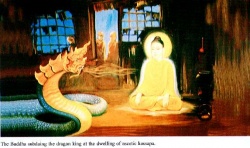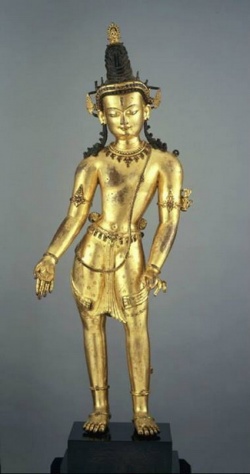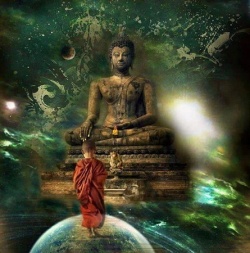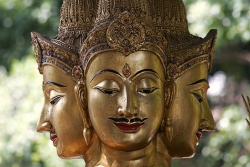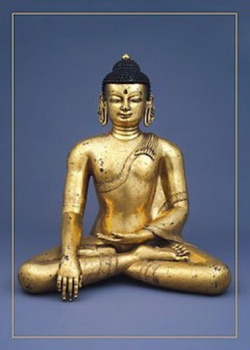Sotāpanna
- See also :
- See also :
In Buddhism, a Sotāpanna (Pali), Srotāpanna (Sanskrit; ch: rùliú 入流, Tib. རྒྱན་ཞུགས rgyun zhugs), or "stream-winner" is a person who has eradicated the first three Fetters (sanyojanas) of the mind.
Sotapanna literally means "one who entered (āpanna) the stream (sota)", after a metaphor which calls the Noble Eightfold Path, 'a stream' (SN 55.5). Sotapannaship (Sotaapatti) is the first of the four stages of Enlightenment.
Attainment
The first moment of the attainment is termed the path of stream-entry (sotāpatti-magga), which cuts off the first three Fetters.
The person who experiences it is called a stream-winner (sotāpanna).
The Sotāpanna is said to attain an intuitive grasp of Dhamma (right view) and has complete confidence in the Three Jewels;
The Sotapanna is said to have "opened the eye of the Dharma" (dhammacakkhu), because they have realized that whatever arises will cease (impermanence).
Their conviction in the true Dhamma would be unshakable.
They have had their first glimpse of the unconditioned element (Nibbana), which they see as the third of the Four Noble Truths, in the moment of the fruition of their path (magga-phala).
Whereas the stream entrant has seen Nirvana though, and thus has verified confidence in it, the Arahant (who is at the fourth and final stage of Spiritual Nobility / sainthood) can drink of its waters, so-to-speak, to use a simile from the Kosambi Sutta (SN 12.68) - of a 'well' encountered along a desert road.
Three Fetters
In the Pali Canon, qualities of a Sotāpanna are described as:
- …those monks who have abandoned the three Fetters, are all stream-winners, steadfast, never again destined for states of woe, headed for self-awakening.
This is how the Dhamma well-proclaimed by me is clear, open, evident, stripped of rags.
The three Fetters which the Sotāpanna eradicates are:
- Identity view - The speculative view that a so-called self exists in the five aggregates (physical forms, feelings/sensations, perception, mental formations and consciousness) is eradicated because the Sotāpanna gains insight into the selfless nature of the aggregates.
- Skeptical Doubt - Doubt about The Buddha and his teaching is eradicated because the Sotāpanna personally experiences the true nature of reality through insight, and this insight confirms the accuracy of The Buddha’s teaching.
- Clinging to rites and rituals - Clinging to the view that one becomes pure simply through performing ritual or rigid moralism, such as relying in a god for non-causal deliverance, slaughtering animals for sacrifice, ablutions, etc. is eradicated because the Sotāpanna realizes that the excessive rites and ritual are nothing more than an obstructive tradition; Deliverance can be won only through the practice of the Noble Eightfold Path.
Defilements
According to the Pali Commentary, six types of defilement would be abandoned by a Sotāpanna:
At least there will be no major transgressions.
Rebirth
[[File:Gaki1.jpg|thumb|250px|Hungry ghost)] A Sotāpanna will be safe from falling into the states of misery (they will not be born as an animal, ghost, or hell being).
Their lust, hatred and delusion will not be strong enough to cause Rebirth in the lower realms.
A Sotāpanna will have to be reborn at most only seven more times in the human or heavenly worlds before attaining Nibbana.
It is not necessary for a Sotāpanna to be reborn seven more times before attaining Nibbana, as an ardent practitioner may progress to the higher stages in the same life in which he/she reaches the Sotāpanna level by making an aspiration and persistent effort to reach the final goal of Nibbāna.
Six wrong actions
Sotāpanna is not capable of committing six wrong actions:
- Murdering one's own mother.
- Murdering one's own father.
- Murdering an Arahant.
- Maliciously injuring The Buddha to the point of drawing blood.
- Deliberately creating a schism in the monastic community.
- Choosing anyone other than a Buddha as one's foremost Teacher.
Textual references
Sutras
The Buddha spoke favorably about the Sotapanna on many occasions, and even though it is the first of Ariya Sangha members, he or she is welcomed by all other Sangha-members for he or she practices for the benefit and welfare of many.
In the literature, the Ariya Sangha is described as "the four" when taken as pairs, and as "the eight" when taken as individuals.
Thus, the first one of the pairs is referred to as the Sotapanna, a stream enterer;
however, when taken as eight individual, the Sotapanna acts not only with stream-entry present but also a Sotapanna (plus), a Noble One who acts for the fruit of stream-entry:
- 'The Sangha of the Blessed One's disciples who have practiced well... who have practiced straight-forwardly... who have practiced methodically...
who have practiced masterfully — in other words, the four types [of noble disciples) when taken as pairs, the eight when taken as individual types — they are The Sangha of the Blessed One's disciples:
worthy of gifts, worthy of hospitality, worthy of offerings, worthy of respect, the incomparable field of merit for the world.'
- Anguttara Nikaya, 11.12
The fifty-fifth Samyutta of the Samyutta Nikaya is called the Sotāpatti-saṃyutta, and concerns Sotapannas and their attainment.
In Sutta-numbers of chapter 1-4, 6-9, 11-14, 16-20, 22-36, 39-49, 51, 53, 54, Sotapannas are praised as Sangha members by and to the sick, lay followers, people on their deathbed, bhikkhunis, Bhikkhus, and devas, and end up for the well being and benefit of many.
Dhammapada
- Dhammapada 178:
- Sole dominion over the earth,
- going to heaven,
- lordship over all worlds:
- the fruit of stream-entry
- excels them.
Chán
- See also Sudden Enlightenment
According to Tripitaka Master Bhikshu Hsuan Hua's Commentary on the Vajra Sutra,
- A Shrotaapanna is a first stage Arhat.
Certification to the first fruit of Arhatship, which is within the Small Vehicle, comes when the eighty-eight categories of view delusions are smashed." p. 77
Venerable Hsuan Hua continues,
- The first fruit is that of Srotāpanna, a Sanskrit word which means "One Who Has Entered the Flow."
He opposes the flow of common people's six dusts and enters the flow of the sage's Dharma-nature.
Entering the flow means entering the state of the accomplished sage of the Small Vehicle.
From Palikanon.com
the 'Stream-winner', is the lowest of the 8 noble disciples (s. ariya-puggala).
Three kinds are to be distinguished:
- the one 'with 7 rebirths at the utmost' (sattakkhattu-parama),
- the one 'passing from one noble family to another' (kolankola),
- the one 'germinating only once more' (eka-bījī).
As it is said (e.g. Pug.37-39; A.III.87):
(1) "If a man, after the disappearance of the 3 fetters
has entered the stream (to Nibbāna), he is no more subject to rebirth in lower worlds, is firmly established, destined to full enlightenment.
After having passed amongst the heavenly and human beings only seven times more through the round of rebirths, he puts an end to suffering. Such a man is called 'one with 7 births at the utmost' (sattakkhattu-parama).
(2) "If a man, after the disappearance of the 3 fetters.... is destined to full enlightenment, he, after having passed among noble families two or three times through the round of rebirths, puts an end to suffering.
Such a man is called 'one passing from one noble family to another' (kolankola).
(3) "If a man, after the disappearance of the 3 fetters.... is destined to full enlightenment, he, after having only once more returned to human existence, puts an end to suffering.
Such a man is called 'one germinating only once more' (eka-bījī).
See; Sotāpatti-Samyutta (S.55).
